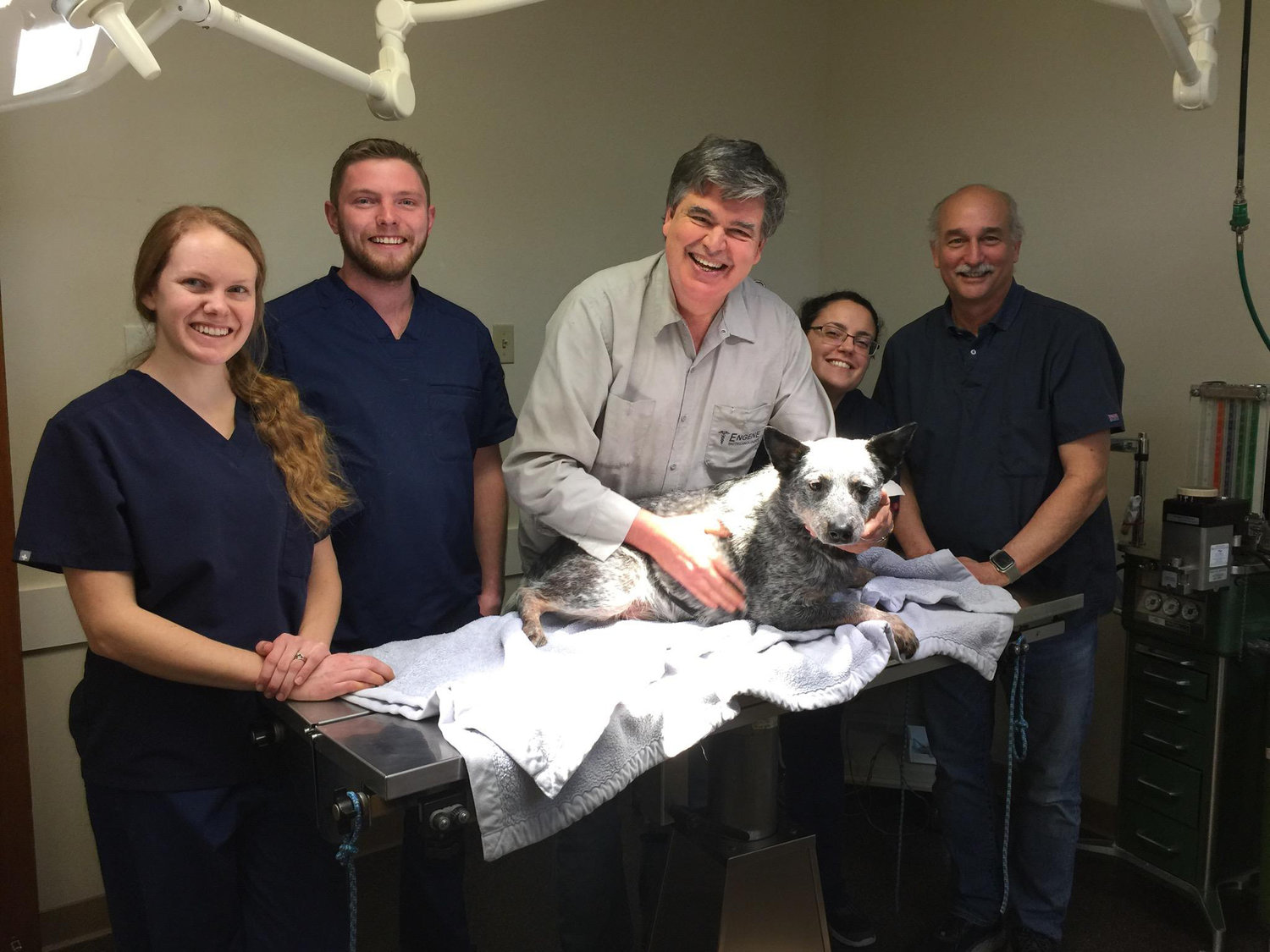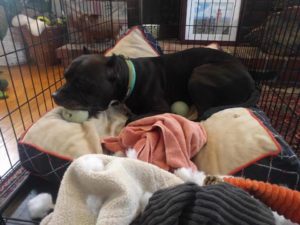
Just like the rock band for which she’s named, the black-and-whitemasked Kiss never gives up, even when people might count her out.
Like KISS, whose members have been rocking for 4 7 years, she keeps coming back, stronger each time, just when you think she’s thrown in the towel. KISS the band is traveling the world throughout 2020 on their The End is Near tour-this time, they say, they’re really going to retire. We’ll believe it when we see it.
Kiss the border collie, however, has no plans to throw in any towel or slow down, and certainly not to retire. This rock star therapy dog/athlete has a can-do attitude that won’t quit, and all the curve balls she’s been thrown so far haven’t taken her down. She’s tough as nails, and yet sweet as the pink swipe of a gentle doggie smooch. She’s one special dog who has defied unthinkable odds to not just survive but also stay at the top of her game.
And what game is that? Well, for starters, she used to give other dogs a run for their money in flyball, agility, dock diving, nosework, and Frisbee catching. But being a top athlete wasn’t where Kiss found her calling. It turns out her best talents emerged during her 11-year career (so far) as a therapy dog-part of the Animal Health Foundation, an affiliate of Pet Partners. Kiss visits hospital patients, helps elementary school children learn to love reading, and appears at many public service events benefiting various causes for pets and children, including her local Rotary Club’s fundraising efforts to raise awareness of skin cancer. Since 2013, she has served as a crisis response dog, sent on deployments where she has helped people affected by disasters or other crises cope with their losses. But her best trick yet? Beating her own cancer, a soft-cell sarcoma on her front left leg, and now living with a complex disease called immune-mediated hemolytic anemia (IMHA). This 13-year-old takes it on the chin, but she never takes it lying down. Despite a grim diagnosis and multiple complications, Kiss is making steady progress and will soon be back visiting her local hospitals and elementary schools, putting smiles on the many faces she loves.
Kiss was six months old when she was given to Jane Horsfield and Dan Balza of Fountain Valley, California, by a fellow flyball enthusiast. Horsfield and Balza previously owned several dogs involved in the sport-which, heartbreakingly, they had lost to various forms of cancer. A lover of border collies, Horsfield was all in for taking Kiss home. However, she and Balza had recently discussed how their household was definitely at its maximum dog capacity. Grudgingly, Balza agreed to take a look at a photo of the striking black and white little furball. It wasn’t long before Kiss became part of the family.
Horsfield describes young Kiss as “one wild little banshee.” She recalls, “She barked, she chased, she screamed … and she ate everything in sight. She chewed clothes, glasses, furniture, walls (not kidding!), and the oak baseboard. I’d get home from work and, with drywall hanging from her mouth, she’d look at me with those big, brown, loving eyes. Who could be mad? Eventually, the bad behavior faded, and a wonderful ‘teenaged’ doggy emerged.”
At that time, Horsfield was doing pet therapy work with another of her beloved athletic dogs, who was 11 and nearing retirement age. All of her dogs do dog sports, but therapy work-that’s a raised bar that Horsfield says only a few dogs can reach. Because Kiss was proving to be a loving and sensitive dog, she began to train her. At just 2 years old, Kiss passed her Pet Partner evaluation, and with that opened
a new chapter in her life. Although her primary job was now therapy work, Kiss still enjoyed participating in dog sports in her spare time.
In 2017, Kiss’s image was featured on a surfboard that was part of a fundraiser by the Huntington Beach Rotary Club. Local artists were paired with local surfboard shapers, and 22 surfboards were decorated and auctioned off, with the money donated to local hospitals benefiting skin cancer research, prevention, and care. At the unveiling of her surfboard, a participant visiting with Kiss felt a swelling on her front left leg and alerted Horsfield to it. It turned out to be a soft-tissue sarcoma, and Kiss was referred to a specialty hospital.
Having lost four previous dogs to cancer, Horsfield and Balza were devastated, fearing the worst. But after 18 months of treatment, including 6 months of rehabilitation, Kiss was declared free of cancer and cleared to go back to work.
Horsfield got word of a grant from the Petco Foundation and Blue Buffalo that was available to therapy dogs with cancer. The foundation donated $3,000 to help cover some of the costs ofKiss’s treatment, and Petco Foundation and Blue Buffalo shared Kiss’s story on their websites for the 2018 Pet Cancer Awareness campaign. The two companies have invested more than $15 million into pet cancer research since the campaign began in 2010. Asked to participate again in 2019, Kiss’s face was featured on ads in People magazine, on Petco’s Pet Cancer Awareness website, on posters in nearly every Petco store, and even on a reuseable tote bag, a gift for donating $10 to the campaign in any Petco store nationwide.
Sadly, between the time she was declared cancer free and the start of the 2019 Pet Cancer Awareness campaign in May 2019, Kiss was diagnosed with immune-mediated hemolytic anemia, or IMHA. “It’s a horrible, not-so-common disease where the immune system goes haywire and starts destroying its own red blood cells,” explains Horsfield. “She literally was fine on Saturday, then on Sunday morning she didn’t want to eat her breakfast.” While that symptom didn’t seem particularly alarming, Horsfield discovered discoloration in Kiss’s mouth and immediately took her to a veterinary specialist. From there, her condition went downhill fast, but thankfully Kiss’s condition today has been mostly stabilized through medication. But not before she suffered an intestinal blockage that required emergency surgery and a severe bout of pneumonia. The road has been long, and it’s been rough. But Kiss is not a quitter. She fights on.
And Horsfield, who “researches absolutely everything” but was too terrified to even look up this disease at first, is fighting along with her. Every day, she’s learning and, more importantly, educating others about IMHA. It’s a complicated disease with no “one-size-fits-all” treatment-veterinarians must try protocol after protocol to find one that strikes the right balance for Kiss. “This story is far from over, and she has not been ‘cured.’ Knowledge is everything when treating this disease,” Horsfield points out. She says if she’d waited a day to take Kiss to the vet or not gone straight to a specialist, Kiss likely would have died, according to her doctors. “Dog owners need to be aware of what IMHA is and know the warning signs” she cautions. “IMHA packs quite a punch, and Kiss’s life has taken a drastic side road.” Younger dogs who make it through this disease are generally more able to get back to normal, says Horsfield. “Kiss got this ugly disease at 12. She’s not a young dog, but she was in great shape before this hit, which is probably why she’s been able to fight it. I am just grateful to still have her with me 12 months after diagnosis.”
While Horsfield admits that Kiss probably won’t be competing in flyball or dock diving anytime soon, she still enjoys her nosework and catching the occasional ball or Frisbee. A pivotal moment in her recovery was when she was finally able to take a swim once again in the family’s backyard pool with her pack, the other family dogs. She’s also back to visiting hospital patients, and will head back to school for the elementary reading program very soon. In December, when a student from Rim of the World High School in Lake Arrowhead was tragically murdered, Kiss was there to lend support. In January, she helped deploying military service men and women and their families prepare for the year ahead.
With all she’s been through, you might expect Kiss to just bask in the sun and take life easy for the rest of her days. But that’s not who she is. That little banshee who barked her head off, ate everything in sight, and chewed her way through puppyhood (and the drywall) isn’t resting on her laurels or her haunches. She’s forging ahead, mending hearts and spreading joy and kisses along the way. Because, sometimes, a kiss changes everything.
Immune-Mediated Hemolytic Anemia
By Julie Stegeman, DVM
Immune-mediated hemolytic anemia (IMHA) is an autoimmune condition wherein the patient’s immune system attacks their own red blood cells as if they were a foreign invader. IMHA is more common in dogs than in cats, and it is an almost daily occurrence in the caseload of a referral hospital because of the need for inpatient supportive care and often the need for blood transfusion. It is most often seen in middle-aged dogs and in young cats, and some breeds are more at risk ( cocker spaniels, miniature schnauzers, miniature dachshunds, etc). IMHA represents a loss of immune system “tolerance of self.” Our immune system has checks and balances built in, but when there is a disturbance in that balance, a red blood cell can “look” like a virus to an immune system cell. It then becomes a target for destruction, leading to severe anemia and death if left untreated.
Symptoms ofIMHA initially can be vague. Lethargy, poor appetite, even a fever may be seen. Pet owners might notice a red or orange discoloration to the pet’s urine, or they might notice pale gums. The gums and skin might even appear yellow (“jaundiced”) due to buildup of bilirubin, which is a byproduct ofred blood cell destruction. Orange stool is also commonly seen. These symptoms lead to taking the pet in to their veterinarian. Blood tests will show anemia and may or may not show elevated bilirubin levels, elevated white blood cells, low platelets, or elevated liver or kidney values. If the platelet count is low, the pet may have autoimmune destruction of their platelets as well-this is called Evan’s syndrome.”
It is recommended to screen for a variety of immune system triggers in an IMHA patient, such as various tick-borne illnesses, viral infections, other infectious diseases, and cancer. Other triggers can include a variety of medications and even (rarely) vaccinations. If there is an underlying triggering condition, the immune destruction will continue until the trigger is eliminated. This is especially important because treatment for IMHA requires immune suppressive medications, and if there is an infectious disease present, the immune suppressant medications will allow the triggering infectious disease to overcome the patient. It is very important to provide a full medical and travel history to the attending veterinarian, so that these issues can be discovered right away. Various blood tests, chest radiographs, and abdominal ultrasounds are usually performed to screen for underlying conditions, depending on the patient and their exact history.
If no inciting cause is identified, then immune suppressive treatment is begun. The cornerstone of immune suppressive treatment is glucocorticoid (steroid) treatment, most commonly in the form ofprednisone or as injectable dexamethasone. High doses of steroids are required at first, because the immune reactions in IMHA are very intense, and progression is rapid if left unchecked. It can take several days to start to see the benefits of the immune suppressive treatments. In some patients, if the immune system is attacking red blood cells at the level of the bone marrow ( where they are being produced), it can take 4 to 6 weeks for stabilization of the red cell levels to occur. Until the red cell level ( often determined with a Packed Cell Volume [PCV]) stabilizes and starts to increase, blood transfusions are often necessary. Transfusions help “buy time” until the steroids can control the situation. Unfortunately, the transfused red blood cells are often destroyed as quickly as the pet’s own red blood cells, so repeated transfusion may be needed.
In addition to steroids and transfusions, sometimes other treatments are used. Intravenous gamma globulin treatment (IVIgG) is an expensive but often effective way to shorten a hospital stay. This treatment binds to auto-antibodies and keeps them from attacking the red blood cells. It also may reduce antibody production by the patient’s body. It helps “win the battle” but is not proven to improve long-term outcomes. Plasmapheresis is another treatment available at a few referral hospitals in the nation, with a similar end result as IVIgG. Other immune suppressive medications such as cyclosporine, mycophenolate, azathioprine, or leflunomide, often started in conjunction with prednisone, take longer for full effect and are most helpful to reduce how much prednisone is given over the long run.
Patients with IMHA have a high risk for development of abnormal blood clots, and pulmonary embolism is actually one of the leading causes of death in these pets. Therefore, it is common to prescribe blood thinners such as aspirin, clopidogrel (Plavix), and/or heparin. A blood thinner is often given as long as the prednisone is given.
Because anemia affects the entire body, gastrointestinal support is often needed, in the form of antacids, anti-nausea medications, and coating agents.
Survival ofIMHA is, unfortunately, not 100 percent. Estimates vary, but the author’s experience is that approximately 75-percent survival is expected. Not all pets respond completely to treatment. Others succumb to pulmonary embolism. Rarely, they develop secondary opportunistic infections, such as fungal infections, due to chronic immune suppressive therapy.
Close monitoring is critical after the patient is discharged from the hospital. A patient may need to be rechecked a couple of times a week at first, gradually reducing to once every 2 to 3 weeks. The medications are tapered over time, and usually by 4 to 6 months after diagnosis, the pet is either off medication entirely or is on the minimum dose of medication required to maintain a normal red blood cell level. Relapses can occur, as can other immune-mediated diseases.
In summary, IMHA is a life-threatening but treatable disease, which most but not all patients survive. A thorough evaluation of the patient is needed initially, and most require hospitalization to survive the initial part of the illness. Long term, the pet owner will need to work closely with their veterinarian to adjust medications and watch for relapses.










